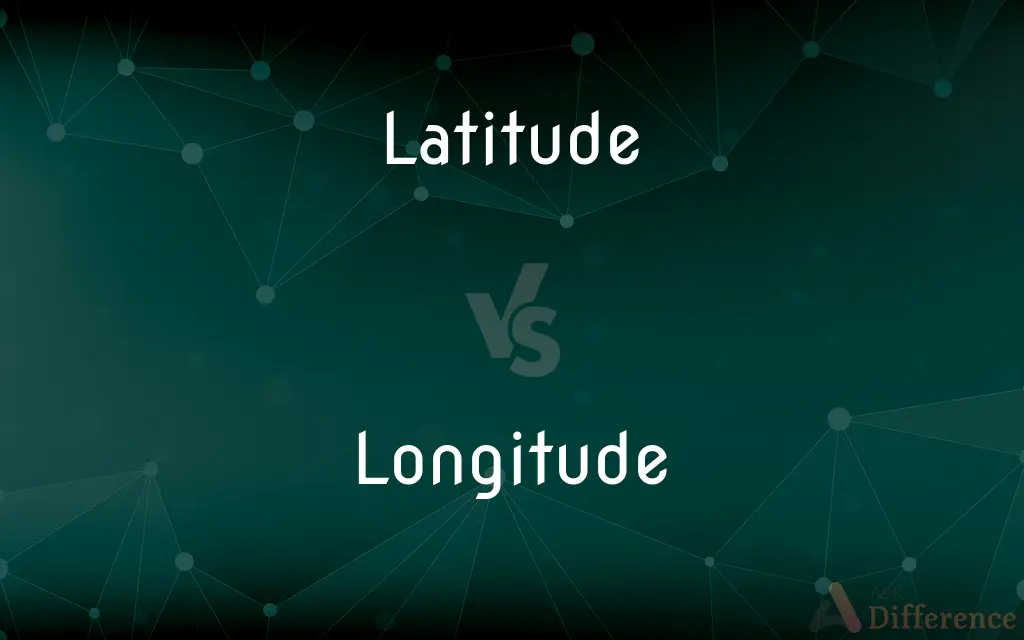Latitude vs. Longitude — What's the Difference?
By Tayyaba Rehman — Updated on September 16, 2023
Latitude measures distances north or south of the equator, while longitude measures distances east or west of the prime meridian. Both are coordinate systems used to specify locations on Earth's surface.

Difference Between Latitude and Longitude
Table of Contents
ADVERTISEMENT
Key Differences
Latitude is a coordinate that specifies the north-south position of a point on the Earth's surface. These lines run parallel to the equator. In contrast, Longitude indicates the east-west position and is measured relative to the prime meridian in Greenwich, England.
The equator, a horizontal circle, is the zero point for latitude measurements. Thus, latitude values can range from 0° at the equator to 90° North or South at the poles. On the other hand, the prime meridian serves as the zero point for longitude measurements, extending from 0° to 180° East or West.
While both latitude and longitude are measures to determine a point's location on Earth, their methods of measurement are different. Latitude lines are equidistant from each other, while the distance between longitude lines decreases as one moves toward the poles from the equator.
Accurately determining longitude was historically challenging for sailors and explorers, given that it requires precise timekeeping. Meanwhile, determining latitude was relatively easier, with the North Star providing a reference point in the Northern Hemisphere.
Together, latitude and longitude coordinates offer a comprehensive system for pinpointing any location on Earth. By knowing the exact latitude and longitude values, one can locate cities, landmarks, or even specific addresses.
ADVERTISEMENT
Comparison Chart
Reference Line
Equator
Prime Meridian
Measures
North-South position
East-West position
Range
0° to 90° North or South
0° to 180° East or West
Parallel Lines
Yes, always equidistant
No, converge at poles
Historical Navigation Aid
North Star in Northern Hemisphere
Precise timekeeping
Compare with Definitions
Latitude
A measure used in geography to pinpoint a location's vertical position.
As you move higher in latitude, temperatures tend to decrease.
Longitude
The angular distance east or west from the prime meridian.
The longitude of Los Angeles is approximately 118.25° West.
Latitude
A system of parallel circles decreasing in size as they move away from the equator.
The Arctic Circle is a latitude located at about 66.5° North.
Longitude
A system of half-circles that run from the North Pole to the South Pole.
As one travels east or west, they're crossing different lines of longitude.
Latitude
The angular distance north or south from the equator.
The latitude of New York City is approximately 40.7° North.
Longitude
A vertical line on a map or chart representing locations with the same longitudinal value.
Despite being on the same longitude, they're in different time zones.
Latitude
A horizontal line on a map or chart representing locations with the same latitudinal value.
Cities on the same latitude can have vastly different climates.
Longitude
Longitude (, AU and UK also ) is a geographic coordinate that specifies the east–west position of a point on the Earth's surface, or the surface of a celestial body. It is an angular measurement, usually expressed in degrees and denoted by the Greek letter lambda (λ).
Latitude
A term describing a place's relative height above or below the equator.
The change in latitude affected the amount of daylight they received.
Longitude
Angular distance on the earth's surface, measured east or west from the Prime Meridian at Greenwich, England, to the meridian passing through a position, expressed in degrees (or hours), minutes, and seconds.
Latitude
In geography, latitude is a geographic coordinate that specifies the north–south position of a point on the Earth's surface. Latitude is an angle (defined below) which ranges from 0° at the Equator to 90° (North or South) at the poles.
Longitude
Celestial longitude.
Latitude
The angular distance of a place north or south of the earth's equator, or of the equator of a celestial object, usually expressed in degrees and minutes
Lines of latitude
At a latitude of 51° N
Longitude
(geography) Angular distance measured west or east of the prime meridian.
Latitude
Scope for freedom of action or thought
Journalists have considerable latitude in criticizing public figures
Longitude
Any imaginary line perpendicular to the equator and part of a great circle passing through the North Pole and South Pole.
Latitude
The angular distance north or south of the earth's equator, measured in degrees along a meridian, as on a map or globe.
Longitude
(archaic) Length.
Latitude
A region of the earth considered in relation to its distance from the equator:temperate latitudes.
Longitude
Length; measure or distance along the longest line; - distinguished from breadth or thickness; as, the longitude of a room; rare now, except in a humorous sense.
The longitude of their cloaks.
Mine [shadow] spindling into longitude immense.
Latitude
(Astronomy)The angular distance of a celestial body north or south of the ecliptic.
Longitude
The arc or portion of the equator intersected between the meridian of a given place and the meridian of some other place from which longitude is reckoned, as from Greenwich, England, or sometimes from the capital of a country, as from Washington or Paris. The longitude of a place is expressed either in degrees or in time; as, that of New York is 74° or 4 h. 56 min. west of Greenwich.
Latitude
Freedom from normal restraints, limitations, or regulations.
Longitude
The distance in degrees, reckoned from the vernal equinox, on the ecliptic, to a circle at right angles to the ecliptic passing through the heavenly body whose longitude is designated; as, the longitude of Capella is 79°.
Latitude
A range of values or conditions, especially the range of exposures over which a photographic film yields usable images.
Longitude
An imaginary great circle on the surface of the earth passing through the north and south poles at right angles to the equator;
All points on the same meridian have the same longitude
Latitude
(Archaic)Width; breadth.
Longitude
A measure used in geography to pinpoint a location's horizontal position.
Changes in longitude can affect local time observations.
Latitude
The angular distance north or south from a planet's equator, measured along the meridian of that particular point.
Longitude
A term specifying a location's position relative to Greenwich, England.
Adjusting to the new longitude meant resetting their watches.
Latitude
(geography) An imaginary line (in fact a circumference) around a planet running parallel to the planet's equator.
Latitude
(figurative) The relative freedom from restrictions; scope to do something.
His parents gave him a great deal of latitude.
Latitude
(astronomy) The angular distance of a heavenly body from the ecliptic.
Latitude
(photography) The extent to which a light-sensitive material can be over- or underexposed and still achieve an acceptable result.
Latitude
Extent or scope; e.g. breadth, width or amplitude.
Latitude
Extent from side to side, or distance sidewise from a given point or line; breadth; width.
Provided the length do not exceed the latitude above one third part.
Latitude
Room; space; freedom from confinement or restraint; hence, looseness; laxity; independence.
In human actions there are no degrees and precise natural limits described, but a latitude is indulged.
Latitude
Extent or breadth of signification, application, etc.; extent of deviation from a standard, as truth, style, etc.
No discreet man will believe Augustine's miracles, in the latitude of monkish relations.
Latitude
Extent; size; amplitude; scope.
I pretend not to treat of them in their full latitude.
Latitude
Distance north or south of the equator, measured on a meridian.
Latitude
The angular distance of a heavenly body from the ecliptic.
Latitude
The angular distance between an imaginary line around a heavenly body parallel to its equator and the equator itself
Latitude
Freedom from normal restraints in conduct;
The new freedom in movies and novels
Allowed his children considerable latitude in how they spent their money
Latitude
An imaginary line around the Earth parallel to the equator
Latitude
Scope for freedom of e.g. action or thought; freedom from restriction
Common Curiosities
Why was determining longitude historically difficult for sailors?
Determining longitude required precise timekeeping, which was challenging during early sea voyages, unlike latitude which had natural references like the North Star.
What's the primary difference between latitude and longitude?
Latitude measures the north-south position, while longitude measures the east-west position on Earth.
Where is the starting point for measuring latitude?
The equator is the starting point or zero-degree line for latitude; for longitude, it's the prime meridian.
How do lines of latitude and longitude intersect?
Lines of latitude run horizontally and are crossed by vertical lines of longitude.
Why are lines of longitude not parallel like latitude?
While latitude lines remain parallel to the equator, longitude lines converge at the poles.
Is the prime meridian the only significant line of longitude?
While the prime meridian is significant for longitude, the 180th meridian, or the International Date Line, is also crucial.
How many degrees of latitude are there from the equator to the North Pole?
There are 90° of latitude from the equator to the North Pole, and the same applies to the South Pole.
Why do different longitudes have different time zones?
Earth is divided into time zones based on longitude to standardize local times, as the planet rotates 360° in 24 hours.
Do latitude and longitude have physical lines on Earth?
No, latitude and longitude are imaginary lines used for mapping and navigation purposes.
What latitude is considered the "middle" of Earth?
The equator, at 0° latitude, is considered the "middle" of Earth, dividing it into Northern and Southern Hemispheres.
Can you explain the Tropic of Cancer's relevance to latitude?
The Tropic of Cancer, at approximately 23.5° North latitude, marks the northernmost point where the sun can be directly overhead.
Which latitude is commonly associated with the Arctic Circle?
The Arctic Circle is located at approximately 66.5° North latitude.
How do GPS devices utilize latitude and longitude?
GPS devices use latitude and longitude coordinates to pinpoint and display a user's exact location on Earth.
Which locations have a longitude of 0°?
The prime meridian in Greenwich, England, represents 0° longitude.
Is there a place where latitude and longitude lines intersect at zero degrees?
Yes, the point where the equator (0° latitude) meets the prime meridian (0° longitude) is in the Gulf of Guinea, off the west coast of Africa.
Share Your Discovery

Previous Comparison
Began vs. Beginning
Next Comparison
Werewolf vs. WarwolfAuthor Spotlight
Written by
Tayyaba RehmanTayyaba Rehman is a distinguished writer, currently serving as a primary contributor to askdifference.com. As a researcher in semantics and etymology, Tayyaba's passion for the complexity of languages and their distinctions has found a perfect home on the platform. Tayyaba delves into the intricacies of language, distinguishing between commonly confused words and phrases, thereby providing clarity for readers worldwide.















































